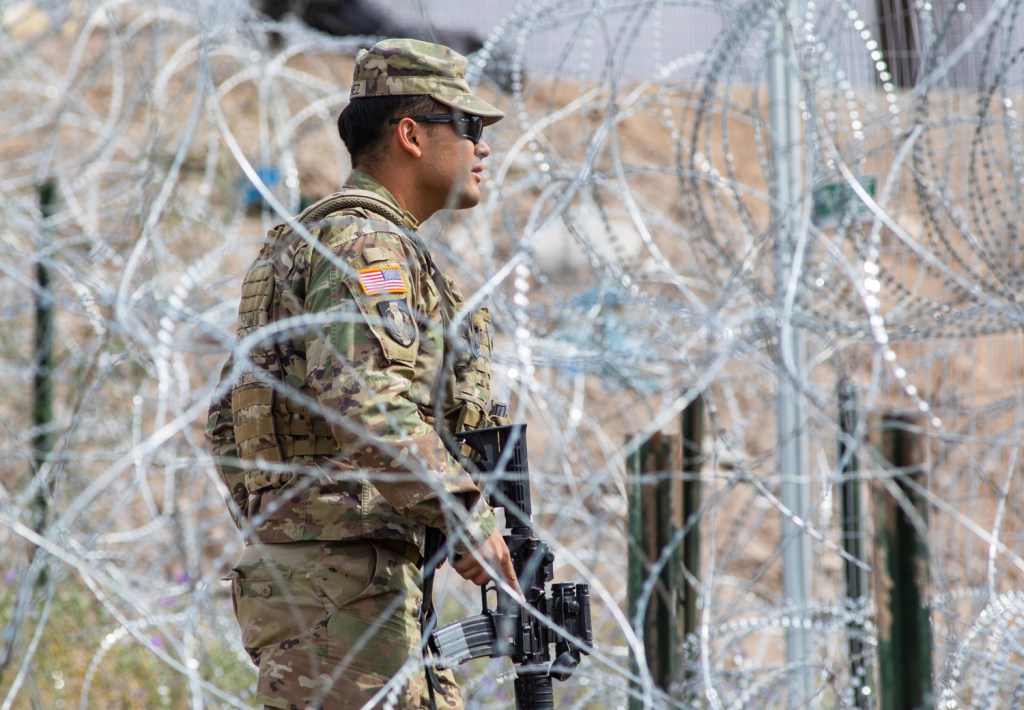More than 13,000 migrants bused out of El Paso in past three months
by Cindy Ramirez, El Paso Matters
December 11, 2023
Genesis sat on the steps of the Union Depot in Downtown El Paso early last week, watching as dozens of recently arrived migrants like herself board buses waiting to transport them out of the region.
She wouldn’t be among them, she regretted.
“There was a mixup with the paperwork and now we don’t know what we’re going to do,” said the tearful 31-year-old mother of Albanis, 13, and Albelis, 11, as she explained that U.S. Border Patrol agents misspelled her younger daughter’s name. “They called them both Albanis.”
The incorrect paperwork prevented the Venezuelan family from boarding a state-sponsored charter bus to Denver, where Genesis hopes to find work. She was in the nursing field in Venezuela, but now is looking to work as a maid, a dishwasher or a cook – anything that will help create a stable life for her and her daughters, she said.
Until their paperwork is corrected and cleared and they can find a way out, Genesis and her daughters will bounce around area shelters or even sleep on the streets – an all-familiar story among thousands of migrants who continue to arrive at the border in waves.
“Enough is enough. How long can we keep this up?” said a man who drove up to the Union Depot to see the situation for himself after seeing a group of people walking toward the train station last week.

Four buses waited for workers to process the migrants – the vast majority on this day families with young children.
“I feel for them, especially the children, but we can’t keep doing this,” said the man who would only identify himself as Josh, a taxpayer and a concerned citizen.
For several days the past week, dozens of migrants again crawled through the concertina wire erected at the Rio Grande by the Texas National Guard to reach the United States through El Paso. They waited by the border wall to request asylum.
Genesis and her daughters were among them.
“Arriesgandonos la vida,” Genesis said in Spanish. “Risking our lives, risking disfiguring our faces or cutting open our heads or even losing a limb. … We risked our lives the entire journey – we all do. … That should tell you how desperate we were to leave our home countries.”
Here are 10 things to know about the migrant situation in the community a year after the region saw a tidal wave of people arrive at the border and thousands sleeping on the streets.
Are migrants still being bused out of El Paso?
Since Sept. 23, following the influx of migrants into the community and the transfer of migrants from other border cities, there have been about 300 charter buses out of El Paso.
The city of El Paso has paid for about 40 of those charters using federal funds; while the vast majority are being paid by the Texas Department of Emergency Management under Operation Lone Star.
In all, more than 13,000 migrants have been bused to New York City, Chicago and Denver from El Paso through charters since late September.
The county of El Paso is still operating its Migrant Support Services Center, which helps arrange travel for migrants who have funds to go to another city. The center has helped nearly 5,350 people in the past month alone – about 1,900 of those the week ending Dec. 3, county documents show. The center operates using federal funds.
Where are migrants being sheltered now?
The network of more than a dozen shelters with Annunciation House and the three Downtown shelters – the Opportunity Center for the Homeless, the Rescue Mission of El Paso and Sacred Heart Catholic Church – continue to house the majority of migrants passing through the community.
Shelter operators say migrants arrive in waves – some larger than others. In the past year, some shelters have built up their facilities, capacity and network of volunteers but the need for more remains.
Is the city still using hotels for migrants?
During a major influx in September, shelters were overwhelmed and the city began putting up migrants in several hotels – up to 1,000 people at a time. Hotels were only used a few days in October and November to temporarily shelter some 20 people at a time, according to the city’s migrant dashboard.
In the past week, the city has put up to 100 migrants in hotels as shelters again saw a spike in the number of arrivals. City officials said it’s sometimes more efficient for the city to use hotels before opening up other facilities.
What happened with the shelter at Nations Tobin Recreation Center and the new emergency shelter at Morehead Middle School?
Nations Tobin was a temporary shelter, which closed because of the low number of overflow from other shelters. The El Paso Independent School District completed the sale of Morehead to the city, which is ready to use as an overflow emergency shelter if needed, city officials said in an email to El Paso Matters.
Why are migrants still sleeping on the streets around Sacred Heart Catholic Church in Segundo Barrio?
Some migrants time out of other shelters or are turned away when they’re at full capacity. Sacred Heart allows migrants to sleep inside its gym at night, giving priority to women and children because of limited space and resources, leaving others to sleep outdoors.
Some migrants choose to sleep on the streets because they don’t want to leave the area where they told relatives who are still in custody they’d be or because they are fearful of leaving the area where they feel safe.
The city maintains six portable restrooms and large trash bins at the site, with crews cleaning the area regularly. Still, trash mounts and bad odors plague the area, neighbors complain.
Will we continue to see Department of Public Safety troopers and Texas National Guard in the community?
The state troopers and state guards working under Operation Lone Star have been in El Paso since last December when Mayor Oscar Leeser issued a disaster declaration over the migrant humanitarian crisis. A second disaster declaration was issued in April. The Texas legislature recently infused more than a billion more dollars into the operation to put up more border barriers while keeping state troopers on the roads and Texas National Guard stationed along the Rio Grande.
Human Rights Watch, an international nonprofit that investigates civil rights abuses, recently issued a report that showed that 68% of all DPS trooper vehicle chases in the state were in 60 Operation Lone Star counties – including more than 300 in El Paso County so far this year.
What’s the latest with the SB4 immigration bill?
Senate Bill 4 – which would allow police to arrest people they suspect of entering the country illegally and allow local judges to order them to leave the country – was approved by the legislature last month.
The bill is still awaiting Gov. Greg Abbott’s signature and would likely become effective in March. Those who support the law argue it’s necessary to stop the flow of migrants, blaming President Biden and the administration for not doing enough to protect the border.

Why does SB4 face opposition?
Calling it the “show me your papers law,” opponents say it will lead to racial profiling and possibly unfairly put residents, citizens and others with authority to be in the country legally through the justice system.
“Any police encounter, whether it is a stop or consensual interaction, could lead to impermissible inquiries into someone's immigration status and lead them into the deportation pipeline,”saidAron Thorn, an attorney for the Beyond Borders Program at the Texas Civil Rights Project.
Thorn was among a group of legal experts, civil rights advocates and faith-based organizations who last week held a virtual press conference led by Las Americas Immigrant Advocacy Center in El Paso to discuss the implications on SB4, urging the U.S. Department of Justice to step in and stop it from moving forward.
Representatives from the ACLU of Texas said they planned to file lawsuits against SB4, calling it unconstitutional.
Will we see another major wave of migrants ahead of SB4 becoming law?
Area shelter operators say they don’t anticipate as large an influx as the record wave the border saw ahead of Title 42 expiring – in December 2022 when it was first set to expire or in May when it actually did. But they don’t rule out anything.
More than anything, said Rescue Mission of El Paso CEO Blake Barrow, it’s the worsening instability and growing insecurity in South American countries such as Venezuela that continue driving migrants to the United States.
John Martin, director of the El Paso Opportunity Center for the Homeless, said there was an increase in the number of people at area shelters the past week but couldn’t predict whether it would last.
“We’re not yet seeing the next big wave – a fourth wave,” Martin said. “But that doesn’t mean it won’t happen.”
What can I do to help migrants in the community?
Shelters are in need of volunteers, monetary assistance and donations of clothing, food, blankets, toiletries and other items, especially winter jackets as colder temperatures arrive.
The Opportunity Center and Rescue Mission also help area homeless people who are in need of assistance with the same items.
Click HERE for a few ways to help.
This article first appeared on El Paso Matters and is republished here under a Creative Commons license.![]()

